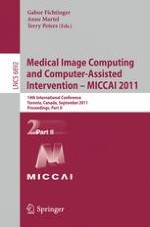2011 | Book
Medical Image Computing and Computer-Assisted Intervention – MICCAI 2011
14th International Conference, Toronto, Canada, September 18-22, 2011, Proceedings, Part II
Editors: Gabor Fichtinger, Anne Martel, Terry Peters
Publisher: Springer Berlin Heidelberg
Book Series : Lecture Notes in Computer Science
